
|
 |
 |
Escape through Time Fire | Car | Plane | Ship 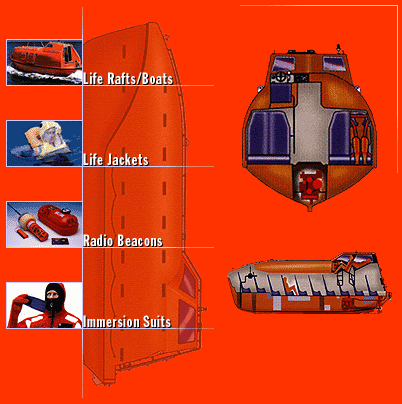
Life Rafts/Boats In the 1950s, use of inflatable life rafts became widespread in the maritime community, when large ships began to carry them as spare survival crafts. These early inflatable rafts could automatically float free of a sinking ship, inflate and be ready for use if lifeboats could not be used. By 1960, life rafts became mandatory for passenger and cargo ships. In 1974, the International Convention on Safety of Life at Sea, or SOLAS, required cargo ships to have enough life rafts to accommodate half of the people permitted on board the ship. These were float-free life rafts intended to be used in the event that lifeboats were unavailable. Drafters of the 1983 SOLAS treaty, agreeing that not providing life rafts for the remaining 50 percent of crew members could lead to a Titanic-style disaster, mandated enough rafts for all on board. Inflatable life rafts have also increased safety on smaller ships, which have limited space. Most modern units have carbon dioxide cylinders that automatically inflate the raft. Due to the increased reliability of these rafts, the 1983 SOLAS treaty allowed cargo ships shorter than 280 feet in length and passenger ships carrying fewer than 200 passengers the option of carrying only life rafts (no lifeboats), as long as they were in sufficient numbers to accommodate everyone on board. Since these life rafts have no means of propulsion, these ships must carry at least one rescue boat, which facilitates man-overboard rescues, assists other ships in distress, and tows life rafts away from danger.
Following two serious sea disasters in 1973, the design of lifeboat launching systems underwent closer scrutiny. The result was the free-fall lifeboat. Relying on TEMPSC technology, Joost Verhoef developed an inclined launching system which, using the natural force of gravity, would allow a totally enclosed lifeboat to simply slide down a ramp and plunge into the water below. Today, free-fall TEMPSC's have been tested at heights of up to nearly 100 feet. They are found on many tankers and most mobile offshore drilling rigs. back to top Life Jackets
Life jackets came into their own after the heroic tests of Dr. Edgar Pask. In order to determine how an unconscious person floated, Pask allowed himself to be anaesthetized and immersed in water wearing only a standard life jacket and a breathing tube. Pask's daring experiments revealed that the best position for the body to be in when bobbing in the ocean is leaning back with the head at a 45-degree angle to the sea surface.
back to top Radio Beacons Lifeboats and life rafts keep people out of the water until they can be rescued, but how do rescuers know where to find them or even know that there has been a casualty? In the past, many ships carried portable lifeboat radios, but they could weigh 40 pounds or more and be difficult to operate.
The 1983 SOLAS treaty contained a new EPIRB requirement for two EPIRBs on either side of a ship. These EPIRBS are intended to be carried to one of the lifeboats or life rafts on that side of the ship, where they will provide a signal for rescuers to home in on. In 1988, SOLAS amended its regulations to include satellite EPIRBs within its search-and-rescue procedures. Satellite EPIRBs send a signal that is received by U.S. and Russian weather satellites, and relayed to ground stations. As the satellite passes overhead, the digital data and frequency change of the distress signal are used to identify and pinpoint the vessel in distress. Morse code, which has long been used for distress communications at sea, has now been phased out. back to top Immersion Suits
Attempts to provide protection against hypothermia are not new. The use of rubber suits dates back to the early part of the century. Although these suits are credited with having saved lives, they were heavy, they generally required a life jacket to be worn underneath, and they tended to leak and fill with water. The danger they posed in terms of lost thermal protective value and added weight for victims trying to climb out of the water spurred the development, during WWII, of lighter-weight suits made of synthetic rubber.
Since 1983, small cargo ships that carry inflatable life rafts as their only survival craft and require survivors to jump from the deck to the rafts have stocked immersion suits for everyone on board. Larger ships with conventional open lifeboats have had to carry only three immersion suits for each lifeboat. These are for the crew operating the lifeboat; passengers in the boat have "thermal protective aids," a type of orange, aluminized suit. back to top Photos/Illustrations: (1) Zodiac International; (2) Norsafe AS; (3,4) NOVA/WGBH Educational Foundation; (5) Prosat Technologies; (6,7) Imperial International, Inc. Escape Through Time | Skydive | Human Response Survivor Stories | Pioneers of Survival | Survival Strategies Resources | Teacher's Guide | Transcripts | Site Map | Escape! Home Editor's Picks | Previous Sites | Join Us/E-mail | TV/Web Schedule About NOVA | Teachers | Site Map | Shop | Jobs | Search | To print PBS Online | NOVA Online | WGBH © | Updated November 2000 |
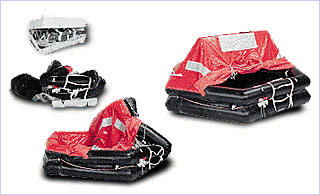 From its start as a spare survival craft on
ocean-faring ships, modern self-inflating life rafts
have become much more prevalent in sea safety. In some
cases they have even been used to replace the
traditional lifeboat.
From its start as a spare survival craft on
ocean-faring ships, modern self-inflating life rafts
have become much more prevalent in sea safety. In some
cases they have even been used to replace the
traditional lifeboat.
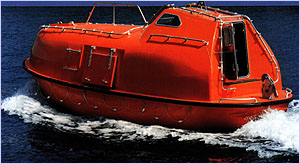 To battle the hypothermic effects of cold climate sea
emergencies as well as to solve the dilemma of deep
sea oil rig evacuations, the Totally Enclosed Motor
Propulsed Survival Craft was developed to provide
shelter for its passengers.
To battle the hypothermic effects of cold climate sea
emergencies as well as to solve the dilemma of deep
sea oil rig evacuations, the Totally Enclosed Motor
Propulsed Survival Craft was developed to provide
shelter for its passengers.
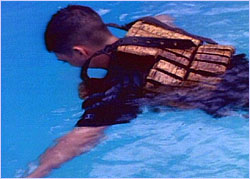 A demonstration of the Victorian cork vest. Despite
its buoyancy, the life vest would fail to keep the
head of the passenger, if unconscious and face down,
above water.
A demonstration of the Victorian cork vest. Despite
its buoyancy, the life vest would fail to keep the
head of the passenger, if unconscious and face down,
above water.
 The modern life vest incorporates an inflated collar,
which props the wearer's head above water, and a
splashguard, which prevents water from entering the
airways of an unconscious wearer.
The modern life vest incorporates an inflated collar,
which props the wearer's head above water, and a
splashguard, which prevents water from entering the
airways of an unconscious wearer.
 To prevent individual survivors from getting
hypothermia, buoyant immersion suits were invented as
an improvement to standard life vests in icy waters.
Above is a demonstration of the immersion suit in
action.
To prevent individual survivors from getting
hypothermia, buoyant immersion suits were invented as
an improvement to standard life vests in icy waters.
Above is a demonstration of the immersion suit in
action.
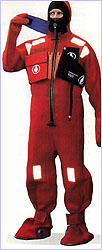 The modern immersion suit incorporates the use of
neoprene fabric to allow the wearer to sustain body
heat and flotation.
The modern immersion suit incorporates the use of
neoprene fabric to allow the wearer to sustain body
heat and flotation.